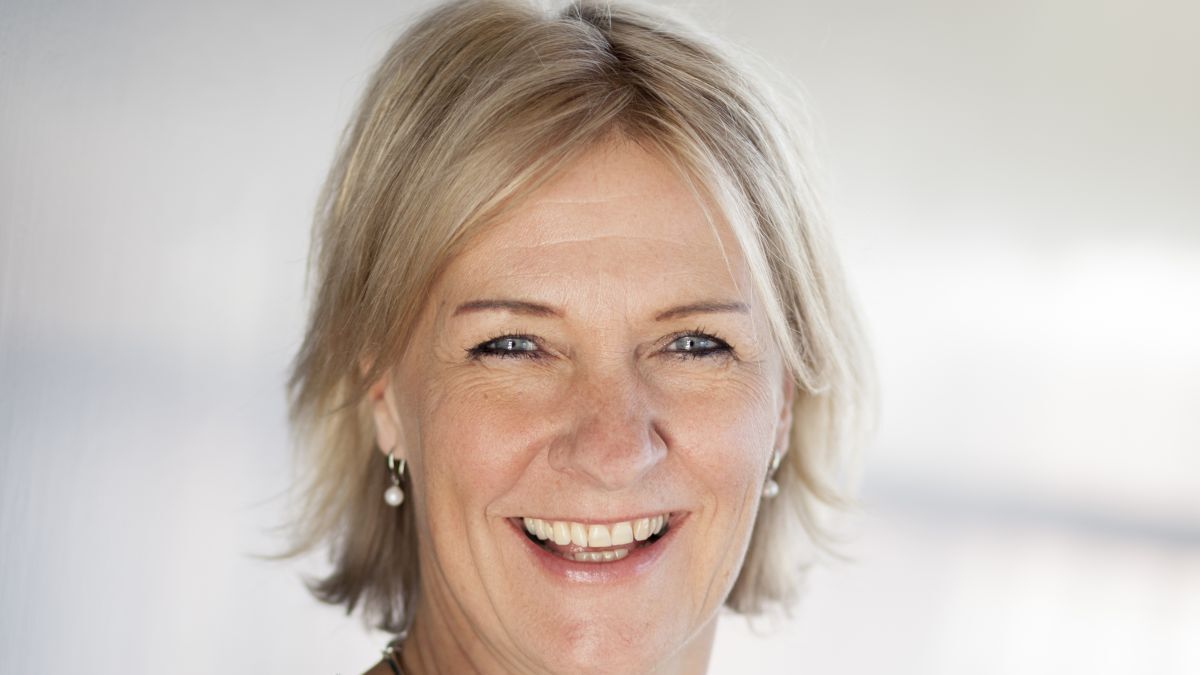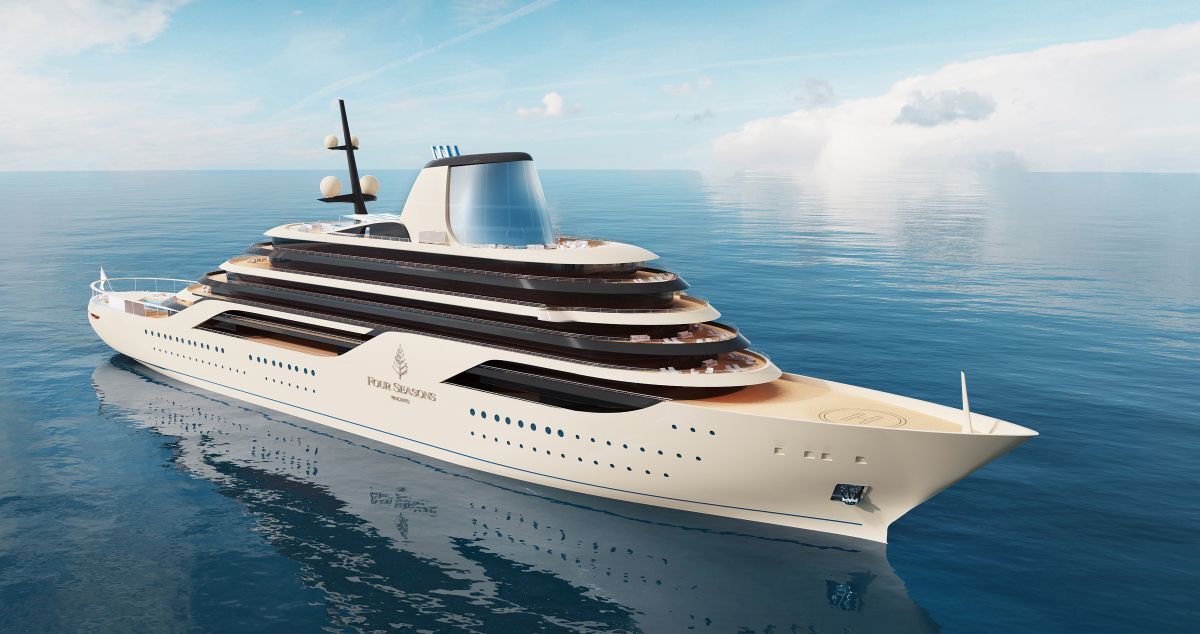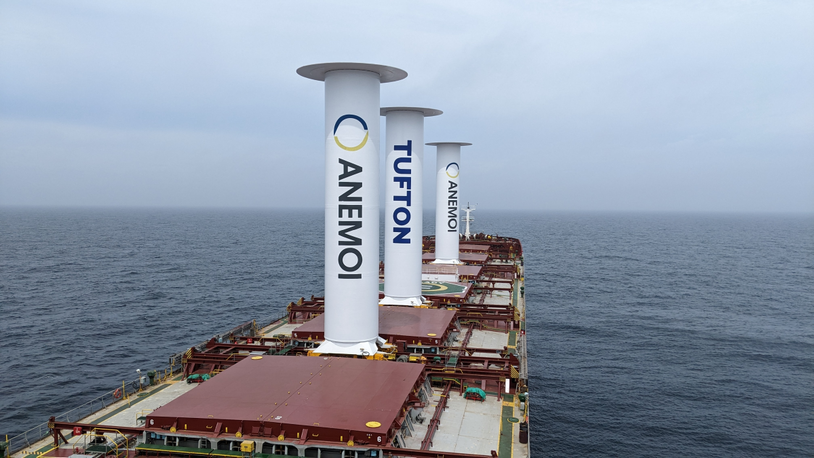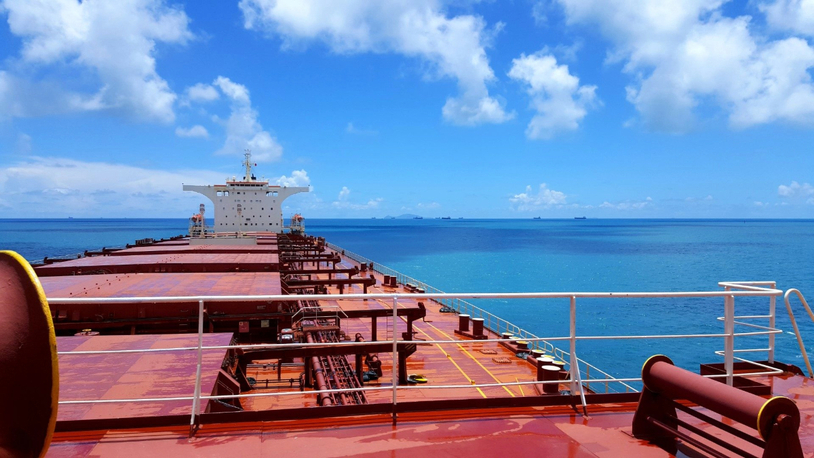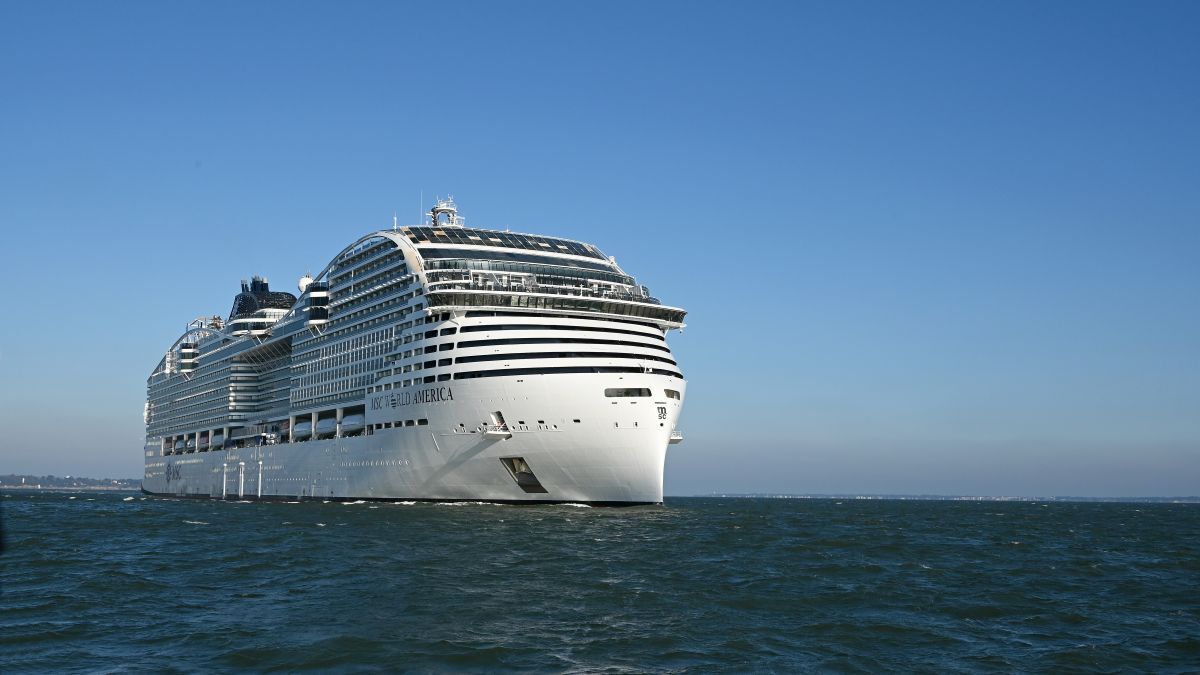Business Sectors
Contents
Natchan World nears completion – and another 112m cat is ordered
The latest vessel to be constructed by Incat, Natchan World, has been launched from the builder’s Hobart yard. This is the second giant fast ferry for Higashi Nihon Ferry and will shortly join sister Natchan Rera – completed by Incat last August – in service across Japan’s Tsugaru Strait between the islands of Honshu and Hokkaido (Ferry Technology, October/November 2007).
At nearly 11,000gt the new 112m-long Natchan World is one of the largest built by Incat but still has a loaded draft of only 3.83m, enabling it to operate in shallow ports. With a speed of approximately 40 knots and capacity for up to 800 persons and 355 cars, or 450 lane metres of trucks and 193 cars, Natchan World is almost identical to its sister.
Changes include a new feature for executive-class passengers; instead of individual seats, there are small booth-style compartments for two to four passengers. In each, passengers are free to take off their shoes and lie down. Massage chairs will also be installed in the same cabin.
Incat has also announced that it has secured its third 112m catamaran order, from MGC Chartering Ltd, due for delivery in February 2009.
Incat Hull 066 is specifically designed with the European market in mind. The new craft will also operate at approximately 40 knots while offering capacity for up to 417 cars or 567 lane metres of trucks and 195 cars. Accommodation will cater for 1,200 passengers in luxurious comfort.
MGC Chartering is an Ireland-based leasing company, and its director, Darryl Tishler, says that: “We have over 25 years’ experience in aviation leasing, and in founding MGC Chartering have adapted that very successful aviation model to the needs of the ferry market. Our intention is to acquire quality assets such as the Incat 112m wave piercing catamaran and then market a range of charter options to potential global operators, be they commercial or military.”
Four new-generation freight roros for Seatruck
In a new phase of its expansion, freight-only specialist Seatruck Ferries has placed an order for four new generation roro vessels with German shipbuilder FSG (Flensburger Schiffbau-Gesellschaft).
These will have a four-deck configuration and provide 151 trailer spaces on an overall length of 142m. They will have a service speed of 21 knots and are planned for delivery between November 2011 and June 2012.
“With a design draft of just 5.2m, they will offer extreme operational flexibility. Decisions on how to deploy the new ships have yet to be taken; options include our existing Irish Sea routes, linking Warrenpoint-Heysham and Dublin-Liverpool,” says Seatruck.
The four decks will be connected by fixed ramps, with access by a single stern door. The newbuildings will be powered by two 8,000kW main engines, and twin 1,000kW bow thrusters and high-lift rudders will enhance manoeuvrability in confined areas.
Commenting on the order, Seatruck chief executive officer Kevin Hobbs said: “We have reached an important stage in the rapid development of our operations and fleet. This new order doubles the newbuilding programme to eight ships. During 2008 we will take delivery of the first four 120-unit vessels, all from the Spanish builder Astilleros de Huelva. The first, Clipper Point, has just joined the fleet, and Clipper Pennant, Clipper Pace and Clipper Panorama will follow during the course of the year.”
Clipper Point and Clipper Pace will join the Warrenpoint-Heysham service (page 22). Clipper Pennant and Clipper Panorama will be deployed on the Dublin-Liverpool route.
Mr Hobbs added: “We are delighted to place this new order with FSG, which has an excellent track record in ferries and a reputation for delivering on time. Our decision to place this order now reflects, in part, the shortage of freight roro tonnage in this smaller class. Freight roro newbuildings entering service are mainly in the larger sizes which are more suited to longer sea crossings. Clearly, we will pursue all appropriate market opportunities afforded by an expanded, young and versatile fleet.”
Over the past six months Seatruck also added four secondhand vessels to its fleet. These are the 121m, 65-unit capacity sisters Arrow, Triumph, Shield and Challenge. Last September, Seatruck also acquired the Dublin-Liverpool route formerly operated by Celtic Link.
Aker Yards launches new princess
The beginning of March saw the christening and launching ceremony of the 212m cruiseferry Baltic Princess, ordered by Tallink from Aker Yards’ Helsinki site in 2005. The contract is worth €165 million and the vessel will start cruises from Helsinki, Finland to Tallinn, Estonia this summer.
According to plans, once in operation the 2,800-passenger Baltic Princess will replace the cruiseferry Galaxy, which will be rerouted to the Turku, Finland to Stockholm, Sweden route, and Festival to the Stockholm to Riga, Latvia service.
“When delivered, Baltic Princess will thus mean a new ship not only for the Tallinn-Helsinki route, but at the same time for three services, when rerouting the two other vessels”, says Keijo Mehtonen, board member of the Tallink Group. “We are looking forward to offering new cruising experiences for all of our passengers,” he adds.
This is the fourth cruiseferry that Aker Yards has built for Tallink, and production of a fifth has already started in the Rauma yard. In addition, the fast ropax ferry Star was delivered last spring from Helsinki.
Austal wins additional catamaran contracts from China
Austal has signed a contract for four additional 47.5m passenger catamarans with Cotai WaterJets (Macao) Ltd, adding to the initial ten-vessel contract signed in 2006 by sister company Venetian Marketing Services Ltd (VMSL). The new ferries will be identical to those delivered and under construction at Austal’s Henderson shipyard (Ferry Technology, February/March 2008) and will be delivered in the first half of 2009.
Completion of the entire 14-vessel order will see the number of Austal designs delivered to China/Hong Kong waters grow to 52, reinforcing the company’s success in that region.
Of the initial ten vessels ordered by VMSL in 2006, five have been completed, with the construction of two catamaran ferries for another Hong Kong operator continuing at Austal’s shipyard in Tasmania, Australia.
Fassmer delivers new ropax for Senegal
At the end of last year German builder Fassmer delivered the 76m ropax Aline Sitoe Diatta to Senegalese operator Somat. This company will revive the sea connection between Senegal’s capital, Dakar, and Ziguinchor in the southern-most part of the country, Casamance. At a cruising speed of 14.5 knots, the voyage will take approximately 12 hours.
Construction of the new ropax has been supported by the Federal Republic of Germany within the scope of German development and co-operation via the Reconstruction Loan Corporation (KfW). In addition, the European Investment Bank (EIB) has also made a considerable contribution to financing, and a small share has been financed directly from Senegal.
This 15.5-m-wide ferry can carry eight trailers and six trucks, and the vehicle deck is accessible via a hydraulic, divided stern ramp. Additionally, 504 passengers in three classes and 39 crew members can be accommodated. The vessel has been designed and constructed to meet Germanischer Lloyd rules.
Since the capsize of Joola during a storm in September 2002, this sea connection has been interrupted, or provisionally operated by a chartered ferry for a limited period. Joola was one of the most important means of transport for the 800,000 inhabitants of Casamance, and when it sank 1,863 people were lost – many more than the certified capacity.
Fassmer says that: “Great attention has been paid to the highest level of safety, ideal manoeuvrability and excellent swell and stability features for this new vessel, particularly on account of the sinking of Joola. To absorb roll, an active tank stabilisation unit has been installed.”
Fassmer also supplied the ferry’s two rescue boats, one support boat and one fast support boat. Aline Sitoe Diatta is also fitted with 12 x 35-person liferafts and four 25-person liferafts, as well as a ‘means of rescue’ boat for 18 people.
Propulsion power is provided by two 1,800kW Wärtsilä 9L20 medium-speed diesel engines, each driving a CP propeller via a Wärtsilä SCV46 gearbox. Bow thrusters from Schottel (STT 330 type) have also been installed.
First new Hart Fenton-designed ferry launched for Wightlink
Wight Light, the first of three new ferries for UK operator Wightlink, has been launched. The trio, which will serve this operator’s busy Lymington-Yarmouth route, have been designed by UK-based naval architect Hart, Fenton & Co. All three ferries are being built at Brodogradiliste Kraljevica, Croatia under the supervision of Wightlink’s project manager, Colin Stanton, who is based at the yard.
These new Wight-class ships, Wight Light, and sisters Wight Sky and Wight Sun (due to be launched in the summer of 2008 and late 2009 respectively) will replace this operator’s elderly C-class vessels, Caedmon, Cenred and Cenwulf, which were completed in 1973.
The newbuilding programme involves a total investment for Wightlink of £26 million, which includes design and construction of the ferries, also shore-based infrastructure work which was required prior to decision to place a contract.
Designed especially for operation on the Lymington river, the new Wight-class ships will be much more efficient than those which have been operating on the route up until now, offering greater flexibility, more manoeuvrability, reduced emissions and more modern passenger facilities.
DFDS invests in new Baltic Sea tonnage
Due to enter service in May 2009 for DFDS – on its Kiel, Germany to Klaipeda, Lithuania service – is a newly-built ropax vessel with capacity for 600 passengers and 2,500 lane metres for freight.
This DFDS-earmarked ferry is under construction at Nuovi Cantieri Apuania in Italy – DFDS has acquired the vessel from Grimaldi Holding, Palermo. This is the fifth newbuilding in a series of eight ordered by Grimaldi from the yard and is 200m in length and 27m wide. It will initially be fitted with 2,500 lane metres for freight and cars, and will have a service speed of 23 knots.
DFDS is investing further to strengthen its network in the Baltic Sea, where the market for freight and passengers is expected to continue to expand in the coming years. Growth is being driven in particular by Russia, CIS countries and the Baltic states.
Pacific Basin enters roro sector
In a US$375 million deal, Odense Steel Shipyard has signed a contract with Pacific Basin Shipping Ltd for two new roros (plus two options) for delivery between 2009 and 2011. These roro designs were originally destined for Epic Shipping, which traded two of its contracts with the Hong Kong-based company.
Pacific Basin Shipping is new to the roro market, but believes that the new ships will strengthen its operations on Asian coasts. The company mainly specialises in bulk transport and has a fleet of 94 ships, of which 33 are owned Handysize bulk carriers, while 61 vessels are on charter.
Elliott Bay completes design of new North Carolina ferry
Elliott Bay Design Group has completed the contract design for North Carolina Department of Transportation’s new 67m (220ft) Sound-class ferry. The design is now with shipyards for bids; at least two hulls will be built and are expected to enter service in late 2009. The new ships will join North Carolina’s existing fleet of 24 ferries, which currently transport more than 1.1 million vehicles and more than 2.5 million passengers over seven routes on Currituck and Pamlico Sounds and the Cape Fear, Neuse and Pamlico rivers.
With capacity for 300 passengers and 50 vehicles, the new Sound-class ferries will service the two-hour Cedar Island to Ocracoke Island and the Swan Quarter to Ocracoke runs in Pamlico Sound. This area is notorious for its sand bars and short, steep seas with strong winds. The hull has therefore been specially designed to reduce pitching and to divert breaking waves and spray for greater passenger comfort. Overnight accommodation for a crew of six is included. FT
Related to this Story
Events
TUGTECHNOLOGY '25
Reefer container market outlook: Trade disruption, demand shifts & the role of technology
Asia Maritime & Offshore Webinar Week 2025
Marine Lubricants Webinar Week 2025
© 2024 Riviera Maritime Media Ltd.






